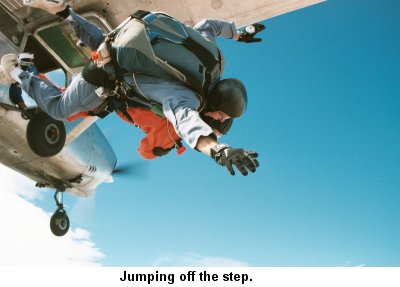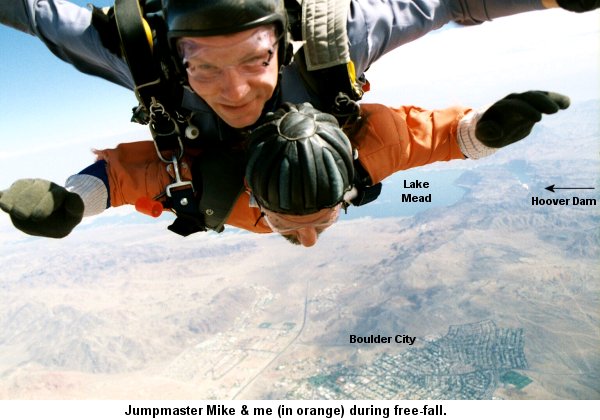Tandem Skydiving

Doing a tandem skydive is one of the most awesome experiences you can imagine. If you've ever considered skydiving I HIGHLY RECOMMEND it. A tandem skydive is where you are harnessed to the front of a jumpmaster. The jumpmaster has a parachute that is about twice the size of a normal chute to support both of you.
There are releases to sign and a video to watch and then your assigned jumpmaster will go over basic exit (from the airplane), free-fall, and landing procedures and positions with you but
there's no long training class involved as if you were trying to become a certified skydiver. On a tandem skydive you're basically just going along for the ride.
Once the training is done you'll be asked to empty your pockets and put your belongings in a locker. You'll then put on a jumpsuit and get harnessed up to wait for your turn to head out to the airplane. Your jumpmaster will lead you out to the plane for the ride up. (It takes a lot longer to go up than it does to come down.)
Guys: Don't be shy about making sure everything is "out of the way" when they put the harness on. There's nothing worse than riding under a canopy with one of your family jewels caught under a harness strap.
If you think you're going to be in a large plane and jumping from a doorway in a standing position, it's not likely. The plane I was on was a small over-wing Cessna with all of the seats removed except for the pilot's. Across from the pilot is a wide door with hinges at the top and when it's opened it swings up under the wing. (In a larger plane you'll likely get up to the edge of doorway on your knees and just roll out.)
Prior to opening the door you'll move up next to it in a kneel down position where you are sitting on your heals facing the forward. The jumpmaster will be in a similar position behind you and he'll start to hook your harness up to his. Then you'll both raise up to a kneeling position and the jumpmaster will tighten your harness connections so that the two of you are tightly harnessed together.
When the door is opened the noise from the engine and the wind is incredible. At this point the plane's airspeed will be down to about 80 miles per hour. You'll see a small step on the right wheel strut. The jumpmaster puts his right foot on this step, toes pointing away from the plane, and then you put your right foot on it also, to the left (inside) of his. Then you cross your arms in front of your chest or grab onto your front harness straps (jumpmaster's preference) and lean out of the plane. As the jumpmaster leans out with you and grabs ahold of the wing strut the only thing still in contact with the inside of the plane is the lower part of your left leg.
You're leaning out of the plane, basically suspended under the jumpmaster, staring down at the ground which looks sooo far away and suddenly the jumpmaster just goes out head first taking you with him. If you're not scared crapless your first time you're insane.

As you start your free-fall the jumpmaster will deploy the small pilot chute to create some drag to lengthen the freewall time and help stabilize the two of you. He will then yell at you or tap you on your arms to signal that you should now extend your arms, arch your back, and curl your legs so you're in the "banana" position. (The wind noise as you free-fall is loud, especially if you're not wearing a helmet.) This is the free-fall portion and the height you jump from determines how long it lasts (about 10 seconds for 8,000 feet vs about 35 seconds from 12,000). The nice thing is that everything is happening so fast and your brain is getting flooded with so many different sensations that there's no time to think about being scared anymore. The fear disappears once you start your free-fall.

During the free-fall you don't have a sensation of falling. All you feel is an extremely strong wind hitting you. You don't even notice the jumpmaster behind you. Skydiving is the fastest sport there is when no mechanical transport is involved. We went from 12,000 feet to 4,000 (where the jumpmaster pulls the ripcord) in about 35 seconds so you are really haulin'.
You are traveling around 120 mph during a free-fall. Your exact speed is your "terminal velocity". Terminal velocity is the point at which your weight (the effect of gravity pulling you down) is balanced with your wind resistance moving through the air and you are no longer accelerating (which is why there is no sensation of falling during the free-fall). Extreme skydivers can increase their terminal velocity during free-fall to around 200 mph by putting their arms back against their sides and falling in a head-down, diving position (which gives them in a more aerodynamic shape reducing their wind resistance).
One thing you'll notice during your free-fall are the goggles you're wearing. The strap has to be adjusted so they fit very tight (so they don't blow off). Then, on top of that, when you look straight down during the free-fall you've got that strong wind pushing them against your face. It doesn't hurt. You're just very aware that you have them on. I just wanted to mention it so you can be expecting it during your free-fall.
Be sure to let them know if you'll be wearing contact lenses during your jump and ask them to put some tape over the vents on the goggles if they don't offer to do so. When contact lens wearers use goggles with vents their eyes tend to water during free-fall which will make your vision blurry.
Because the rental goggles tend to be very basic and get used heavily, you may want to consider ordering your own pair of goggles from Kroop's Goggles (www.kroop.com). Be sure to specify the "skydive punched" (vent holes) clear lens. If you're going to be wearing contact lenses when you jump you'll want to specify the "Ventless" lens so your eyes don't water during free-fall. (There are still a couple small vent holes in the lens to prevent fogging but there are no other vent holes along the sides.) They also have a Custom Eyeglass model which will fit over eyeglasses (get the skydive-punched clear lens on those also).
Before you know it you'll suddenly feel a hard yank on the harness you're wearing and you quickly straighten up-right as the main chute deploys. It feels like you're being pulled upward but you're not. You are just decelerating against the harness. They pull the ripcord at 4,000 feet to give you about 5 minutes of canopy time. This is the best part of the dive in my opinion. There's no feeling like it in the world. If you wish, the jumpmaster will likely let you grab the "toggles" (steering loops) from him and execute some turns. There's only a very little wind noise during the canopy ride so you can converse easily with the jumpmaster.
All too soon the ground is all too close and you have to get ready for the landing. Contrary to a popular misconception, landing is not like "jumping off a three-foot high platform" because you tend to land going more horizontally than vertically (like a plane). It's more of a slide than a drop. Not only that, but your jumpmaster will "flare" the canopy (by pulling down hard on both steering toggles simultaneously) just prior to landing which slows your movement dramatically. You go into the landing with your toes pointing up. As soon as your heels hit you drop your toes down to slide your feet. Then you just slide down onto your butt. This is the safer way to do it. If two people tried to land standing up your legs could get tangled up possibly causing injury.
One of the people who jumped before me got sick during their jump. They were fine and in great spirits 5 minutes after landing, but if you're the type who suffers from motion sickness you may want to take some Dramamine before you head to the airport.Note: Be sure to where a pair of shoes with laces and tie them up tight. Slip-ons, sandles, etc. would likely fly off during free-fall.
If you're taking the skydiving service's shuttle, don't take much with you to the airport. You have to empty your pockets and remove watches, etc. and put them in a locker. If your hair is long in the back and you're not going to be wearing a helmet, try and tuck it inside the jumpsuit or put it in a ponytail to keep it out of the jumpmaster's face during the free-fall. Needless to say, you'll want to use the restroom before they put you in a jump suit and get you all harnessed up. If the drop zone is busy it may be some time before you get a ride up.
Trust me, it'll be around 6 of the most memorable minutes of your life. I enjoyed it so much I've done a couple more tandems at a drop zone near my home and have started AFF (Accelerated Free-Fall) training to get certified. (A list of drop zones around the country that are sanctioned by the USPA is available on the www.uspa.org website. Most offer various training options - AFF, static-line, etc.) Once you get certified and are jumping on your own the cost of a jump drops below $40 (for equipment rental and plane ride). Of the various training methods available, I'd recommend static line. It eases you into the skydiving experience, especially freefall which is the most difficult part to master. (At 120 mph the air isn't very forgiving of misplaced arms and legs.)
Tandem Jumps Count! The USPA requires 25 training/coach jumps to get an 'A' license. If you think you may pursue skydiving training, be sure to write down all of the facts about your tandem skydive because even these jumps count towards this total. Write down date, time, location, type of plane you jumped out of, exit altitude, time (in seconds) of free-fall, etc. You may even want to get a log book ahead of time and have your jumpmaster sign it after you fill in the information. Skydiving magazine sellslog books for $8. I prefer the Skylog 3 model.
"If being in a plane is flying, then riding in a boat is swimming." Enjoy your dive !